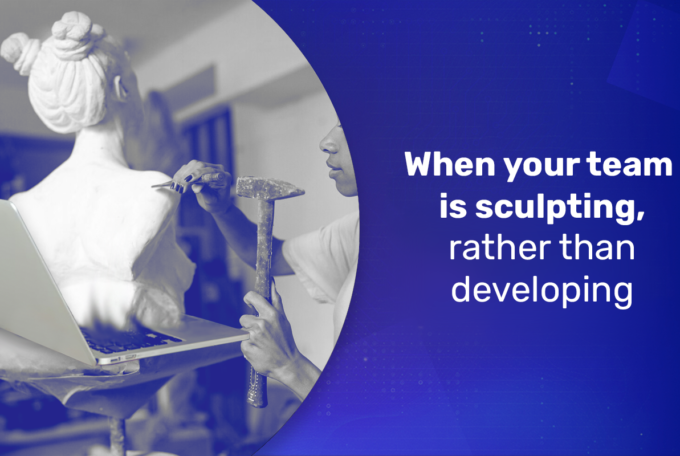Although Business Process Automation is nothing new, global digitalisation has elevated it to a whole new level. BPA and RPA solutions facilitate the effective development of organisations, which is best evidenced in Stepwise customers. Nowadays, you have access to use the best Business Process Automation and RPA solutions, irrespective of the size of your organisation. Find out what BPA and RPA are, what benefits they offer, and how you can implement them successfully into your business.
Entrepreneurs are often surprised by the fact that so many processes and operations in companies can be enhanced by means of technology. In very simple terms, Business Process Automation consists of identifying, improving and integrating a wide variety of apparently independent processes together into one digitalised system, which optimises total costs, saves time, and maintains a high level of service quality.
Business Process Automation and RPA:
- save your team time,
- reduce the employee frustration from repetitive work,
- accelerate company operations,
- improve efficiency and service quality,
- reduce the number of errors.
What are Business Process Automation and Robotic Process Automation?
Both of these terms are used interchangeably in the market. Indeed, they have a lot in common and constitute an inseparable whole in the digital transformations of companies. Although they are intended to increase company effectiveness by improving particular processes in the organisation, they are two separate terms that need to be differentiated.
Business Process Automation (BPA) assumes a holistic approach to automating business processes. It does not focus on individual solutions, but rather transforming and combining several processes at various organisational levels. The task of BPA is to integrate all applications used in the company in order to improve activities (and co-activities) tied to both the front-office and back-office (e.g. after an online order is placed and paid for, the system sends relevant notifications to the customer, the e-store service and to the warehouse).
Unlike BPA, Robotic Process Automation (RPA) has an operational nature and focuses on particular automation solutions. Technology performs the routine repetitive tasks, in effect relieving staff (such as when the bot sends the first message to visitors of our website). RPA enables logging in, identifying of changes and errors, and correcting essential elements, all without human interference. Machine learning and artificial intelligence have considerably increased the possibilities of bots in business. Today, RPA solutions enhance corporate operations, assist in risk management, and support management staff in decision-making.
Example
Imagine an accountant in a company, doing a variety of tasks every day: issuing and managing invoices, sending notifications of payments, performing transactions, and maintaining the income and expense ledger (or comprehensive bookkeeping). This first simple description of the position indicates how many of the tasks can be done by a computer.
Irrespective of the size of the company there is a large number of these tasks, yet we would like to concentrate on invoices. One of the tasks related to invoice management can be e.g. copying data (the name of the counterparty, invoice number, amount) from the invoices to a spreadsheet, which is then sent upline along with other financial reports to a superior.
When performed by one person, these tasks are all quite time-consuming, repetitive and frustrating. While working with a large number of documents, there is a high risk of human errors. Robotic Process Automation can be helpful in this respect.
If a particular task can be performed by a computer, there is a good chance that this process can be automated. As far as invoice management is concerned, it is sufficient to create a simple bot which upon receiving an electronic invoice (pdf, jpg) can use OCR, recognise the text in the document and convert it into a relevant format. The bot then enters the data to the financial report and sends an email upline.
The Stepwise case study:
Stepwise also uses RPA solutions, e.g. we do appreciate Zapier, which we use for optimising HR processes. This tool gathers resumes, extracts the most important information and sends it to Slack (an application for asynchronous communication and project management), which then creates a new task and sends a direct notification to the relevant people.
The business benefits of Business Process Automation and RPA
- Time-efficiency and cost-efficiency
Computers do not get tired or frustrated, and they do not make errors. For this reason, they work faster and perform tasks more effectively. In addition, technology does not incur costs associated with motivation or remuneration for overtime. Business Process Automation saves time and money, that you can use for expanding your business.
- Improved knowledge management in an organisation
Employees relieved of repetitive or menial tasks are free to have their attention, creativity and engagement turned toward more engaging activities. Automation processes are first created by people who bring invaluable knowledge into a company. BPA facilitates crystallising this knowledge and using it for the future. In this way, the company is less exposed to staff changes and becomes independent of individuals. A well-prepared automation process allows looking at all aspects of corporate operations more objectively, as well as noticing and correcting potential mistakes.
- Relieving people of tiring repetitive tasks
People are ambitious by nature. Involved employees would like to develop, so performing the same tasks all the time lead to frustration. Doing repetitive work is tiring and discouraging. Relieving employees of these activities and entrusting them with more ambitious tasks will increase their motivation and let them develop, which translates into the expansion of your company.
- Faster task completion
All BPA and RPA events are registered and undertaken in real time. Technology can combine a wide variety of tools and applications, and the automation allows performing several tasks simultaneously. There is no risk that an employee will “miss” an important email as the computer instantly responds to the various events.
- Continuity of work (24/7)
Cloud services software can operate nonstop, which eliminates downtime. Cloud infrastructure guarantees a high efficiency and reliability. As a result, your company has “a virtual employee” that is available 24 hours a day 7 days a week.
- Short implementation time for a solution
There are a lot of tools for digital process automation in the market that can be implemented in one day. Despite this, generic solutions are not effective for all businesses. If you would like to build your own system, it can take more time than with off-the-shelf solutions, and it is still feasible.
At Stepwise, software for Business Process Automation is developed using the Business Process Model and Notation (BPMN), which facilitates describing the structure and implementing process automation.
- Fast return on investment
Efficient development and configuration of software for Business Process Automation and RPA allows you to immediately use the advantages of these solutions. Ready technologies are generally available as subscriptions, where implementation takes little time, and you can use ready applications straightaway.
- Enhanced customer experience
Business Process Automation with the use of cutting-edge technologies facilitates responding quickly to events in business. Immediate responses largely improve the company image in the eyes of their customers, partners and employees.
- Lower demand for IT services
When it comes to BPA and RPA systems, the increased technological potential of a company is not tantamount to employing more IT specialists. While using cutting-edge tools and solutions, you do not need a team of developers or dedicated software as appropriately automated and configured processes are done independently.
How does Stepwise use automation in customer projects?
The Stepwise case study:
One company in the FinTech Self Learning Solutions sector was looking for a solution to a problem associated with enhancing business processes related to the analysis and assessment of credit risk in the financial industry. The business goal was to create a platform that supports loan and credit companies with the use of an engine facilitating assessment and making decisions.
At Stepwise we are looking for ways to improve business process management. During our initial discussions we evaluated their expectations and needs. Our thorough research showed that none of the solutions in the market met our customer requirements. They decided to create their SaaS platform from the ground up.
To create the BPA software, we used special technology that serves for building and running business processes efficiently. A process is created in the form of blocks and it is specified which activities are to be automated and for which human intervention is required. The employee whose work is to be automated describes exactly what he or she does, so that the software can then process this data into a finished process. That automation saves time and money, particularly with an increased number of requests to be processed
Our solutions considerably shortened the time of considering financial applications. Any changes in documents can now be made in one place, instead of introducing changes manually in each document.
The major benefits that convinced their end users to use our customer’s new software are:
– 80% reduction in costs of new features in IT Development of Smart FinTech Platform;
– 80% reduction in maintenance costs;
– 50% reduction in infrastructure costs thanks to Cloud;

The PBA software development process at Stepwise
Optimum development of the BPA and RPA software is not straightforward and consists of several complex tasks. At Stepwise we divide these projects into 4 main stages.
- Planning stage
Identifying all repetitive processes in the company. Automation makes sense when a repetitive process changes frequently. In the case of fixed processes that do not change, it is worth considering whether automation is necessary, and if so, whether using technology already available in the market is possible. Not all software houses are aware of tools that considerably facilitate dedicated technology development and save the customer money. Aside from identifying particular processes, it is important to distinguish the activities performed within each process and the links that exist between them.
- Development stage
At this stage our specialists encode or configure particular processes. This is done by means of existing technology or with the support of a created solution.
- Deployment and testing stage
We implement solutions and thoroughly check each process. If no errors occur and everything works smoothly, we launch the software and deliver it to our customer.
- Support and process maintenance stage
Subsequent to implementing the software for Business Process Automation, we observe the system and gather key process metrics. At this stage Stepwise uses advanced tools for collecting, analysing and reporting of data. In this way, our customers have a full insight into the automation, and are free to make effective business decisions and optimise the operations of their companies.
The major areas of use of BPA software and types of automation processes
The areas of RPA use:
- Finance and banking
In these branches, processes change very frequently and dynamically. Automation technologies need to quickly adapt to the environment and market.
- IT
Here automation is very clear, as a wide variety of operations can be automated. A multitude of applications and tools are used in IT and therefore an appropriate integration of particular processes is significant.
- Human resources
Even in smaller companies recruitment and data collecting processes can be considerably improved. For larger companies this is a salvation from the hordes of applications and abundance of information.
- Insurance agencies
Processing performance and data security are significant in this respect. Cloud services and an innovative attitude to preparing particular processes enhance the effectiveness of operations while maintaining the highest security standards.
- Marketing and sales
Business Process Automation in marketing saves time and directs attention back to creative concepts and increased ROI for advertisements. CRM systems and tools for gaining and nurturing leads are often used here. Customer service and post-sales services have a huge potential for digital automation.
- Customer relationship management
Contact bots, forms and customer service using new technologies can significantly improve a company’s PR and help in building the image of a professional organisation in the eyes of customers.
Examples of automation processes:
- Business Process and Case Management Platforms
Tools like Flowable allow Stepwise specialists to use advanced BPMN process engines. BPMN is a standard used by business analysts. Models are created as blocks, which makes them more comprehensible than procedures described in ordinary language.
- RPA
Robotic Process Automation uses robots for performing the repetitive tasks that are usually done by humans.
- Machine-learning algorithms
This technology supports Business Process Automation by processing data and searching for patterns. Thanks to machine learning, software is constantly learning and improving the results of process operations.
- Voice assistant or chatbots
Chatbots can relieve employees from answering repetitive customer questions. These solutions enable contact to customers that are interested in our services and had left their phone number on our website, all in just a few seconds.
- NLP
Natural Language Processing understands and expresses human speech. It serves for developing voice assistants, accelerating writing articles and other texts, and creating instant transcriptions. - OCR
Optical Character Recognition is a technological solution that allows an application to read data (e.g.) from an invoice that is in the form of an image (e.g. jpg, png). The system reads the information, converts it to a textual format and then places it in the designated destination, e.g. a report or accounts.
Summary
Business Process Automation using cutting-edge technologies improves the effectiveness of corporate operations, irrespective of the industry. Of course, the earlier you take care of appropriate identification and description of your procedures, the better. But remember that it can never be too late to implement automation in your business.
Software for Business Process Automation should be tailored to the individual needs of your company, no matter whether you create the system from the ground up, or use solutions available in the market. If you are not experienced in this area, it is advisable to seek the help of a professional partner, e.g. Stepwise.
Our developers have been working on the perfect business software development process for years. Thanks to our extensive experience we can offer comprehensive support in planning, implementing and optimising of effective automation solutions in your company.
Owing to our best software development practices and comprehensive recognition of customer business needs, the technologies we deliver are reliable, save money, and relieve human resources. If you would like to improve your business effectiveness and need a thorough consultation, contact us.




